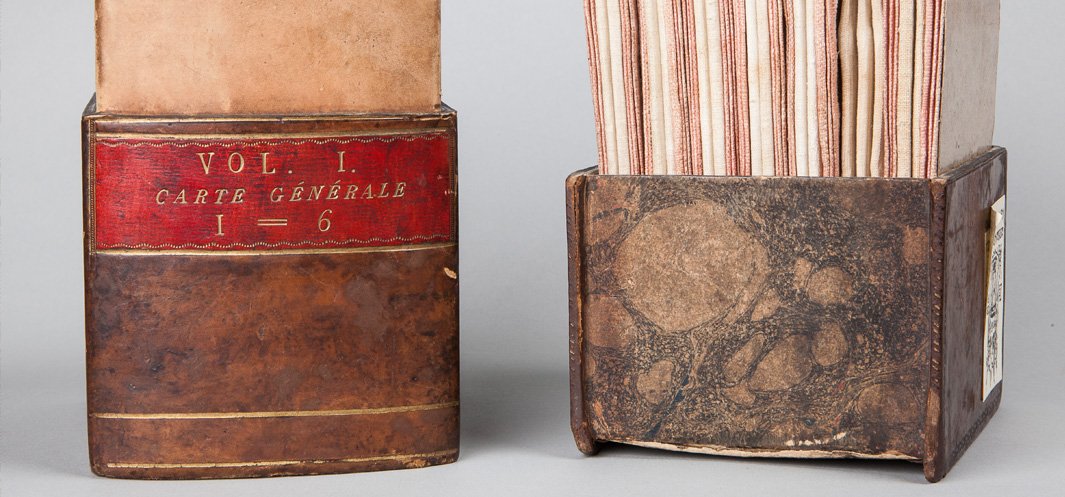Department of Old Prints, Manuscripts and Cartography
The Department numbers 44,338 objects (42,379 inventory items): old prints, individual maps, atlases, stamps and seals as well as parchment documents
The collection of old prints consists of several independently created collections, considerably dominated by Polonica, i.e. publications printed in Poland, written by Poles, on the subject of Poland, complemented by works of ancient, medieval and modern literature, of the themes related to history, law, liturgy and prayers (of various denominations), science and literature. It also contains items documenting public life, best represented by a collection of several thousand so-called ephemeral prints, which include publications of the Constitution, announcements, speeches and the Old Polish Sejm projects.
Old prints from the NMK collection also present the achievements of centuries-old crafts – book bindings made of leather placed on a board or cardboard, decorated with embossed compositions, some in gold, with protective metal fittings, or covered with velvet with openwork metal decoration.
Thanks to the inclusion of the collection of Emeryk Hutten-Czapski Junior, the cartography section has become one of the richest Polish holdings of old maps of the Polish-Lithuanian Commonwealth.
The collection of stamps and seals – fruit of archival queries of Krakow historians of the late 19th and early 20th century – constitutes particularly valuable material of documentary and educational nature pertaining to Polish sigillography from the Middle Ages to the 20th century
The Department is interested in acquiring unique objects – 'rara avis' – with antique fittings and interesting illustrations in form of woodcuts or copperplates, as well as maps. Years-long experience tells us that purchase offers are rare and few, and donations of old books – infrequent. The Department will always opt for buying or accepting objects whose uniqueness will allow for a better presentation of the achievements of the ancient art of printing, woodcuts, copperplates, cartography or book binding, as well as important documents or sigillographic items. In the next few decades, we should also prepare for the possibility of acquiring copies or collections of newer books – dating back to the 19th century – richly illustrated, first bibliophilic editions or items belonging to prominent historical personas. These types of trends in collectors' interest are readily apparent in the offers of large Western European and American auction houses.
- Old prints section: over 31,000 volumes divided into prints from the 15th, 16th, 17th, 18th and 19th centuries as well as panegyrics and calendars. Presently, there is also a separate subsection containing magazines and music documentation.
- Cartography section: 3,870 objects
- Manuscripts section (sigillography and parchemt documents): 8,613 objects (7,198 inventory items) [excluding manuscripts that are not yet acquired]
The collection of old prints consists of several independently created collections, considerably dominated by Polonica, i.e. publications printed in Poland, written by Poles, on the subject of Poland, complemented by works of ancient, medieval and modern literature, of the themes related to history, law, liturgy and prayers (of various denominations), science and literature. It also contains items documenting public life, best represented by a collection of several thousand so-called ephemeral prints, which include publications of the Constitution, announcements, speeches and the Old Polish Sejm projects.
Old prints from the NMK collection also present the achievements of centuries-old crafts – book bindings made of leather placed on a board or cardboard, decorated with embossed compositions, some in gold, with protective metal fittings, or covered with velvet with openwork metal decoration.
Thanks to the inclusion of the collection of Emeryk Hutten-Czapski Junior, the cartography section has become one of the richest Polish holdings of old maps of the Polish-Lithuanian Commonwealth.
The collection of stamps and seals – fruit of archival queries of Krakow historians of the late 19th and early 20th century – constitutes particularly valuable material of documentary and educational nature pertaining to Polish sigillography from the Middle Ages to the 20th century
The Department is interested in acquiring unique objects – 'rara avis' – with antique fittings and interesting illustrations in form of woodcuts or copperplates, as well as maps. Years-long experience tells us that purchase offers are rare and few, and donations of old books – infrequent. The Department will always opt for buying or accepting objects whose uniqueness will allow for a better presentation of the achievements of the ancient art of printing, woodcuts, copperplates, cartography or book binding, as well as important documents or sigillographic items. In the next few decades, we should also prepare for the possibility of acquiring copies or collections of newer books – dating back to the 19th century – richly illustrated, first bibliophilic editions or items belonging to prominent historical personas. These types of trends in collectors' interest are readily apparent in the offers of large Western European and American auction houses.
